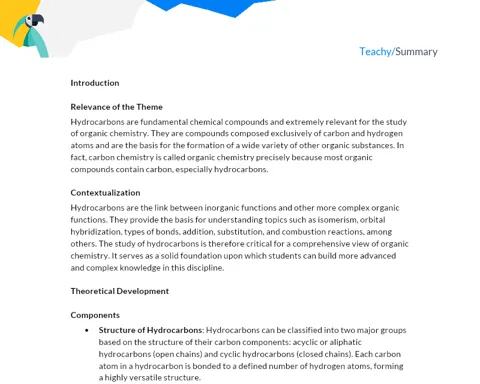Organic Functions: Ether | Traditional Summary
Contextualization
Ethers are organic compounds widely used in various fields, from the chemical industry to medicine. They have a characteristic chemical structure, where an oxygen atom is bonded to two distinct carbon atoms. This particular configuration gives ethers unique properties that make them valuable in various applications. For example, their ability to dissolve a wide range of substances makes them useful as solvents in industrial and laboratory chemical reactions.
In addition to their practical use, ethers also play a significant historical role. Diethyl ether, for example, was one of the first general anesthetics used in surgeries, marking an important advance in medicine. Currently, ethers continue to be essential components in fragrances and perfumes due to their pleasant aroma. However, it is important to emphasize that ethers can form hazardous compounds, such as explosive peroxides, when exposed to air for long periods, requiring specific care in their handling.
Chemical Structure of Ethers
Ethers are organic compounds in which an oxygen atom is bonded to two distinct carbon atoms, forming the general structure R-O-R', where R and R' are alkyl or aryl groups. This configuration is crucial for defining the properties of ethers. The C-O-C bond is one of the distinctive features of ethers, differentiating them from other organic compounds like alcohols or esters.
The geometry of ethers is approximately tetrahedral around the oxygen atom, but with bond angles slightly different from the 109.5° expected for a perfect tetrahedron due to the repulsion between the non-bonding electron pairs on oxygen. This results in C-O-C bond angles closer to 112°.
The presence of oxygen imparts a moderate polarity to ethers, where oxygen is partially negative and the carbons are partially positive. However, the polarity of ethers is not as pronounced as that of alcohols, since ethers do not form strong intermolecular hydrogen bonds.
-
General structure: R-O-R'.
-
Tetrahedral geometry around oxygen with C-O-C bond angles close to 112°.
-
Moderate polarity without strong intermolecular hydrogen bonds.
Nomenclature of Ethers
The nomenclature of ethers can be done in two main ways: by common nomenclature and by IUPAC nomenclature. In common nomenclature, ethers are named by listing the alkyl groups in alphabetical order followed by the word 'ether'. For example, CH3-O-CH3 is called 'dimethyl ether'.
In IUPAC nomenclature, ethers are considered as oxy substituents. The name is constructed by naming the smaller group as an 'oxy' substituent and the larger group as the main hydrocarbon. For example, CH3-O-CH3 is called 'methoxymethane', and CH3-CH2-O-CH3 is called 'methoxyethane'.
It is important for students to practice identifying different ethers and applying the nomenclature rules to ensure accuracy and clarity in scientific communication.
-
Common nomenclature: alkyl groups + 'ether'.
-
IUPAC nomenclature: smaller group as 'oxy' substituent + main hydrocarbon.
-
Examples: 'dimethyl ether' and 'methoxymethane'.
Physical Properties of Ethers
Ethers possess unique physical properties due to their chemical structure. They are generally volatile liquids and have lower boiling and melting points than alcohols of similar molecular weights. This occurs because ethers do not form strong intermolecular hydrogen bonds, resulting in lower intermolecular forces and consequently less energy required for phase change.
Ethers are moderately polar due to the difference in electronegativity between oxygen and the carbons to which it is bonded. However, this polarity is not sufficient to allow hydrogen bonding with other ether molecules, although they can form hydrogen bonds with water molecules, giving them some water solubility.
These physical properties make ethers effective solvents in many chemical reactions, as they can dissolve a wide variety of substances without reacting with them.
-
Volatile liquids with low boiling and melting points.
-
Moderately polar, but without strong intermolecular hydrogen bonds.
-
Effective solvents due to the ability to dissolve multiple substances.
Chemical Properties of Ethers
Chemically, ethers are relatively inert, meaning they do not react easily with many chemicals. This makes them useful as solvents in chemical reactions where the reactivity of the solvent must be minimal to avoid interfering with the reactions of the reagents.
However, an important and hazardous characteristic of ethers is their tendency to form explosive peroxides when exposed to air and light for long periods. Ether peroxides are extremely unstable and can detonate upon impact, heat, or friction, making the proper storage of ethers and regular testing for peroxide detection essential.
Additionally, ethers can undergo acid cleavage under strong acidity conditions, resulting in the formation of alcohols and alkyl halides. This reactivity, although limited, is important in certain organic syntheses.
-
Relatively inert, ideal as solvents.
-
Formation of explosive peroxides with prolonged exposure to air and light.
-
Can undergo acid cleavage forming alcohols and alkyl halides.
Applications and Importance of Ethers
Ethers are widely used in industry and daily life due to their unique properties. In the chemical industry, ethers are frequently used as solvents due to their ability to dissolve a wide range of substances without reacting with them. Diethyl ether, for example, is a common solvent in chemistry laboratories.
In medicine, diethyl ether was one of the first general anesthetics used in surgeries. Although its use has declined with the development of safer anesthetics, its historical importance is undeniable. Currently, ethers are still used in pharmaceutical and cosmetic formulations.
Ethers are also essential components in fragrances and perfumes due to their pleasant aroma. Additionally, due to their relative chemical inertia, they are used in various industrial applications, including the manufacture of fine and intermediate chemicals.
-
Solvents in chemical reactions due to their inertia and dissolution capacity.
-
Historical use as anesthetics and ongoing application in pharmaceutical formulations.
-
Components of fragrances and perfumes due to the pleasant aroma.
To Remember
-
Ether: Organic compound with an oxygen atom bonded to two distinct carbon atoms.
-
R-O-R': General formula of ethers where R and R' are alkyl or aryl groups.
-
IUPAC Nomenclature: System of naming organic compounds based on specific rules.
-
Moderate Polarity: Characteristic describing the uneven distribution of electronegativity in a compound.
-
Ether Peroxides: Hazardous compounds formed by the oxidation of ethers in open air.
-
Acid Cleavage: Reaction in which an ether is split into alcohols and alkyl halides under acidic conditions.
-
Diethyl Ether: A widely known ether historically used as an anesthetic and solvent.
Conclusion
Ethers are organic compounds of great importance, characterized by an oxygen atom bonded to two distinct carbon atoms. Their distinct chemical structure defines their physical and chemical properties, such as moderate polarity and the lack of strong hydrogen bonds, resulting in lower boiling and melting points compared to alcohols of similar molecular weights. Additionally, the relative chemical inertness of ethers makes them useful as solvents in many industrial and laboratory chemical reactions.
The nomenclature of ethers can be done both by common nomenclature and by IUPAC nomenclature, with specific rules for identifying and naming these compounds. It is crucial for students to practice these rules to ensure accuracy in scientific communication. The chemical properties of ethers, such as the formation of explosive peroxides and acid cleavage, are also important aspects to be considered, especially in laboratory and industrial contexts.
Ethers have various practical applications, from the historical use of diethyl ether as an anesthetic to their current role as solvents and components in fragrances and perfumes. Knowledge of ethers is essential not only for understanding organic chemistry but also for practical application in different industries, highlighting the relevance of the topic for students and encouraging them to explore more about the subject.
Study Tips
-
Review the examples of ether nomenclature, practicing with different compounds to strengthen understanding of IUPAC and common rules.
-
Study the physical and chemical properties of ethers compared to other organic compounds, such as alcohols and ketones, to better understand their differences and similarities.
-
Research practical applications of ethers in industry and everyday life, identifying products and processes that utilize these compounds, to connect theory with practice.



